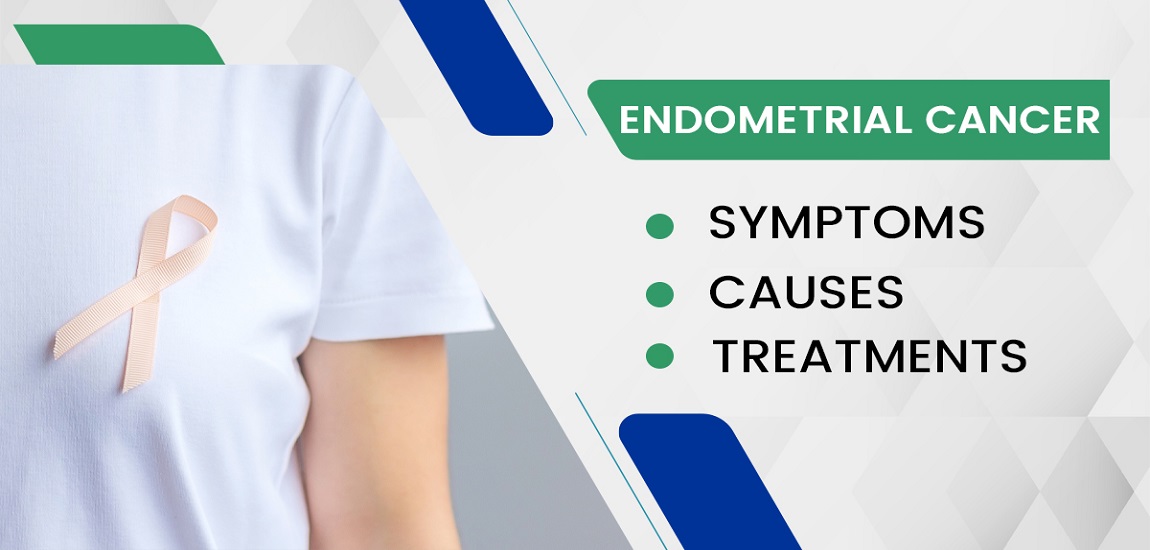
- By JRSH Admin
- In Health and Tips,
- Posted May 28, 2022
Endometrial Cancer – Symptoms, Causes and Treatments
Cancer of the uterus is called endometrial cancer. During pregnancy, the uterus forms a hollow, pear-shaped organ in the pelvis that guides the development of a fetus.
The layer of cells that form the inner lining of the uterus is the site where endometrial cancer starts. It is also known as uterine cancer. The uterus can also develop cancers such as uterine sarcoma, but they are less common than endometrial cancers.
The early detection of endometrial cancer is usually attributed to abnormal vaginal bleeding caused by the disease. A uterus cancer can be removed surgically if endometrial cancer is discovered early.
NCI Trusted Source reports say that approximately 3 in 100 women will be diagnosed with uterine cancer during their lifetime. Uterine cancer patients survive for more than 80 percent of their lives after being diagnosed.
A timely diagnosis and treatment of endometrial cancer will improve your chances of remission.
Symptoms of Endometrial Cancer
Cancer of the uterus can display similar symptoms to several other conditions. This is especially true when it comes to diseases affecting the reproductive system. Consult your healthcare provider if you experience unusual pain, leaking, or bleeding. The most effective treatment depends on an accurate diagnosis.
The few common symptoms of endometrial cancer include:
- There is vaginal bleeding between periods before going into menopause.
- A small amount of bleeding or spotting postmenopause.
- Just below your belly, you might experience lower abdominal pain or cramping.
- A thin, clear, or white discharge if you've gone through menopause.
- Vaginal bleeding that is extremely prolonged, heavy, or frequent after 40.
- Pink or watery discharge that may turn brown or thick, and smell foul during periods.
- Difficulty urinating.
- A pelvic examination can detect an enlarged uterus.
- Sexual discomfort.
- Loss of appetite.
Causes of Endometrial Cancer
The exact cause of endometrial cancer is usually unknown. There are some risk factors associated with this cancer, like obesity and hormonal imbalances. However, experts believe that hormones such as estrogen and progesterone play a major role.
These sex hormone levels affect your endometrium when they fluctuate. The shift in estrogen balance causes the endometrial cells to divide and multiply.
It is possible for endometrial cells to become cancerous if certain genetic changes occur. As a result, a tumor develops quickly. Scientists are still investigating the changes that lead to cancerous endometrial cells.
Risk factors of Endometrial cancer
Many factors increase your chances of getting ill, including cancer. For example, smoking and sun exposure are risk factors that can be changed. Some things cannot be changed, such as a person's age or family history.
Endometrial cancer isn't always caused by certain factors, but it can increase a woman's risk. Most women who have risk factors won't develop the disease.
The cause of endometrial cancer is unknown for some women. There's no way to know which risk factor caused a woman's endometrial cancer, even if she has one or more risk factors.
The risk factors of endometrial cancer include:
- Hormonal imbalances in females. Estrogen and progesterone are produced in the ovaries of women. The endometrium is affected by fluctuations in hormonal balance. If your body produces more estrogen, but not progesterone, you are at a higher risk of developing endometrial cancer.
These may include diabetes, obesity, and polycystic ovary syndrome, which causes irregular ovulation patterns. Endometrial cancer is increased by the use of estrogen-containing but not progesterone-containing hormones after menopause.
- Long last mensturation. A woman's risk of endometrial cancer increases if she starts menstruating before 12 years of age, or when she begins menopause later in life. You have exposed your endometrium to estrogen more often as you have had more periods.
- No pregnancy. In women who have never been pregnant, the risk of endometrial cancer is higher than for women who have been pregnant at least once.
- Older age. Risk of endometrial cancer increases as you grow up old. This cancer mostly occurs after menopause.
- Obesity. Being fat or obese may raise your risk of cancer. A person's balance of hormones may be disrupted by excess body fat.
- Diet/nutrition. Uterine cancer may increase in people who eat foods high in animal fats.
- Breast cancer hormone therapy. It is possible to develop endometrial cancer after taking Tamoxifen for breast cancer treatment. Your doctor should be made aware of this risk if you are taking Tamoxifen. There is a small risk of endometrial cancer, but the benefits of tamoxifen outweigh this risk.
- An inherited colon cancer syndrome. Hereditary nonpolyposis colorectal cancer (HNPCC), also known as Lynch syndrome, is a syndrome that increases the risk of colon cancer and other cancers, as well as endometrial cancer.
There is a gene mutation that causes Lynch syndrome that is transmitted from parent to child. Discuss your risk of Lynch syndrome with your doctor if a family member has been diagnosed. Your doctor can recommend cancer screening tests for you if you are diagnosed with Lynch syndrome.
Prevention of Endometrial Cancer
Different types of cancer are caused by different factors. Researchers are still looking into what causes uterine cancer and how to prevent it. Although there is no proven way to prevent uterine cancer entirely, you may be able to reduce your risk. Speak with your health care team to learn more about your cancer risk.
The prevention tips that you can take to prevent endometrial cancer are:
- Using contraception pills. Birth control pills contain estrogen and progesterone, which are taken in cycles to produce a monthly menstrual period. This reduces the risk of uterine lining overgrowth, especially when taken over a long period.
- Using a birth control device that secretes progestin - intrauterine device (IUD).
- Before starting HRT, consider the risk of uterine cancer, particularly estrogen replacement therapy alone, which is associated with an increased risk. HRT using a combination of estrogen and progesterone may help reduce risk. However, combined HRT is linked to an increased risk of breast cancer.
- Living a healthy lifestyle and maintaining weight, ideally with a BMI of less than 25.
- If you have diabetes, you can reduce your risk by carefully managing your disease, such as regularly monitoring your blood glucose levels.
Diagnosis of Endometrial cancer
Doctors may recommend a physical and pelvic examination for women who are experiencing symptoms of endometrial cancer. Endometrial cancer detection tests are divided into two categories: ultrasound and endometrial tissue sampling.
- Ultrasound waves to produce images of the reproductive system that can be done externally or internally:
- A transducer, which resembles a small wand, is moved over the skin of the lower abdomen during the pelvic ultrasound. Preparation may include drinking water, as a full bladder aids in the creation of better images.
- The doctor inserts a probe through the vagina to capture images of the uterus during a transvaginal ultrasound, which provides a more detailed view of the uterus. This test detects uterine tumors, thicker endometrium, and any abnormalities in the myometrium, the muscle layer of the uterus.
- The most common endometrial cancer test is an endometrial biopsy. The doctor inserts a thin, flexible tube through the cervix into the uterus and suctions a small piece of endometrium out. The suctioning procedure usually takes less than a minute. Before the procedure, the doctor may prescribe a nonsteroidal anti-inflammatory drug (NSAID) such as ibuprofen or administer a local anesthetic injection to numb the area.
- In Examining the pelvis, your doctor carefully examines the outer portion of your genitals (vulva), then inserts two fingers of one hand into your vagina while pressing the other hand onto your abdomen to feel your ovaries and uterus. He or she will also insert a speculum into your vagina. The speculum opens your vagina so your doctor can examine it and the cervix for abnormalities.
Treatment of Endometrial cancer
Surgery is usually the only treatment needed for most women with uterine cancer, particularly if it is detected early and has not spread to other parts of the body.
Surgery:
Surgically removing the uterus and cervix is the most common method of treating uterine cancer. It is called a hysterectomy. During a salpingo-oophorectomy, both ovaries and the fallopian tubes are removed as well.
Removing the ovaries is often done to reduce the chance that cancer will return. This is because the ovaries produce estrogen, a hormone that may spur cancer to spread.
Laparotomy or laparoscopic surgery can be performed by cutting into the abdomen or by using a keyhole. A general anesthetic will be administered. Your surgeon can remove additional tissue during this procedure if cancer has spread, or if you have lymph nodes in your pelvis.
Radiation therapy:
It is common to use radiation therapy as an additional treatment to reduce the chances of cancer returning. Radiation therapy involves using x-rays to kill or injure cancer cells. If surgery cannot be performed, this treatment may be recommended.
Radiation therapy may be given either externally, by directing a machine's beam of radiation at cancer and surrounding tissue, or internally, by placing thin tubes of radioactive material inside the body near cancer.
Hormone therapy:
In most cases, hormone therapy is utilized when cancer has spread or when it has returned (recurred). When surgery is not an option, hormone therapy may also be utilized.
A woman with uterine cancer is usually treated with progesterone, which can be taken in tablet form or administered by injection by her doctor or nurse. Progesterone can reduce the size of some tumors and help control symptoms.
Chemotherapy:
Some types of uterine cancer can be treated with chemotherapy. This can be used when cancer returns after surgery or radiotherapy, or if it does not respond to hormone therapy.
Symptoms can be controlled with chemotherapy as well as pain relief. Drugs are usually injected intravenously (through a vein). You can ask your doctor what chemotherapy will consist of and how long it will last.
Tags
Blog Search
Latest Posts
-
Dark Circles Under The Eyes: Causes, Home Remedies and Treatments
December 21, 2025 -
बर्ड फ्लू के लक्षण, कारण, उपचार और बचाव के उपाय जानें
December 04, 2025 -
Best Diet Plan for Menopause Weight Management
November 25, 2025 -
Pulmonary Fibrosis Treatment: Understanding Lung Scarring and Breathing Problems
November 21, 2025 -
Arrhythmia: Types, Causes, Symptoms, and Treatment
November 07, 2025




